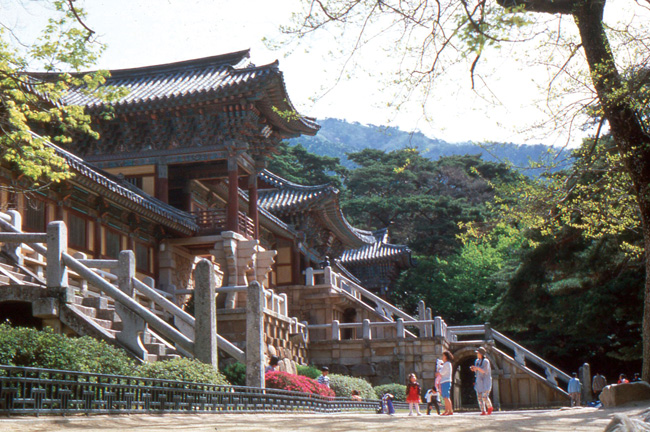|

Kyongju
Kyongju was once the capital of the Shilla Kingdom and subsequently the centre of Korea when Shilla unified the peninsula in 676. It was designated by UNESCO as one of the world's ten most historically significant sites. It is no wonder that this area is called the "Museum Without Walls".
Chomsongdae Observatory: The world's earliest known existing observatory, this 7th century bottle-shaped stone structure, probably built during the reign of Queen Sondok, is admired by archaeologists worldwide. Its diameter at its base is 5.17m(17ft.) and it stands 9.4m(31ft.) high.
Anapchi Pond: The Shilla royal family relaxed and enjoyed themselves and entertained important guests at Anapchi Pond. Surrounded by trees, ponds and natural stones, it is a harmonious royal garden.
Pulguksa (Bulguksa) Temple: One of Korea's best known temples, Pulguksa, on the western slopes of Mt. Tohamsan, is a monument to both the skill of the Shilla architects and the depth of Buddhist faith at the time.
While most of the wooden buildings have been rebuilt over the centuries, all the stone bridge, stairways and pagodas are original. In 1995, Pulguksa Temple was added to UNESCO's World Heritage List.
Seokuram (Sokkuram) Grotto: Dating back to the same era as Pulguksa, Seokuram Grotto is one of Asia's greatest Buddhist shrines. The building of the granite dome of Seokuram was a truly amazing architectural feat. In 1995, it was added to UNESCO's World Heritage List.
Tumuli Park: Tumuli Park is a collection of royal Shilla tombs located in the middle of Kyongju City. The tombs are shaped like grassy hillocks. The park contains 20 tombs, of which Chonmachong (Flying Horse Tomb) is the most famous. The Chonmachong was excavated in 1974, and yielded more than 10,000 treasures.
These treasures including a golden crown and girdle are all placed in the Kyongju National Museum. The tomb itself is open for viewing and provides visitors with an opportunity to see how the huge tombs were constructed and how items were arranged in them.
Kyeongju Folk Handicraft Village: A place where descendants of Shilla's master artisans work. The village consists of an exhibition hall, a shop and 17 workshops producing metallic wares, ceramics, woodcraft, jewellery, embroidery and bamboo works. The village is open all year round.
Kyongju National Museum: Numerous precious relics of Shilla are here. The main hall displays an extensive collection including those from prehistoric times, Ancient Tomb Hall has treasures excavated from Shilla tombs and Anapji Hall contains the relics found at the Shilla's palace pond, Anapji. In the museum garden is another famous symbol of Shilla people's artistic and religious spirit, the Divine Bell of the Great King Seongdeok, which is also named Emile Bell after its mysterious resonant sound.
|
|
|


Donation
678-978-2220
|